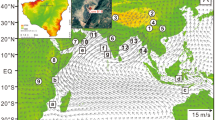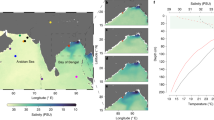Abstract
Guliya ice core records, high lake-level records in the Qinghai-Xizang Plateau and at its north side as well as vegetation succession records indicated that during the period of 30–40 kaBP, namely the later age of the megainterstadial of last glacial period, or the marine oxygen isotope stage 3, the climate of the Qinghai-Xizang Plateau was exceptionally warm and humid, the temperature was 2–4°C higher than today and the precipitation was 40% to over 100% higher than the current average, all these suggested the existence of an exceedingly strong summer monsoon event. It has been inferred that the occurrence of such an event was attributed, on the one hand, to the stronger summer low pressure over the Plateau, which strengthened the attraction to the summer monsoon; on the other hand, to the vigorous evaporation of the tropic ocean surface, which promoted the moisture-rich southwest monsoon to flow over the Qinghai-Xizang Plateau. The background responsible for the formation of the very strong summer monsoon was that the period of 30–40 kaBP was just in the strong insolation stage of the 20ka precessional cycle, when the Qinghai-Xizang Plateau received extraordinary strong solar radiation and thus enlarged the thermodynamical contrast between the Plateau and the midsouth part of the Indian Ocean.
Similar content being viewed by others
References
Imbrie, J., Hays, J. G., Martin, D. G.et al., The orbit theory of Pleistocene climate: support from a revised chronology of the marine δ18O record,Milankovitch and Climate, New York: Reidel Pub. Company, 1984, 269–305.
Lorius, C., Polar ice cores, climate and environment records, inProceedings of the International Conference on Climatic Impacts on the Environment and Society 1–7Tsukuba, Japan, 1991.
Fabre, A., Leteguilly, A., Ritz, C.et al., Greenland under changing climates, sensitivity experiments with a new dimensional ice sheet model,Annals of Glaciology, 1995, 21: 1–7.
Yao Tandong, Thompson, L. G., Shi Yafenget al., A study on the climate changes from Guliya ice core records since Last Interglacial Period,Sciences in China, Ser. D, 1997(6): 447.
Thompson, L.G., Mosley-Thompson, E. D.et al., Glacial stage ice core records from the subtropical Dunde Ice Cap, China,Anna1 of Glaciology, 1990, 14: 288–294.
Zhang Pengxi, Zhang Baozheng, Lowenstein, T. K.et al., Origin of Ancient Abnormal Kalium Evaporite-Taking Kali Salt in Qarhan Salt Lake as an Example (in Chinese), Beijing: Science Press, 1993.
Chen Kezhao, Bowler, J. M., Preliminary study on the relations between the Qarhan Salt Lake features and the paleoclimate evolution in the Qaidam Basin,Science in China, Ser. B (in Chinese), 1985, 5: 463.
Li Bingyuan, Zhang Qingsong, Wang Fubao, Lake evolutions in the Karakomm Mountains-West Kunlun Mountains regions,Quaternary Research (in Chinese), 1991(1): 64.
Zheng Mianping, Xiang Jun,Salt Lakes in the Qinghai-Xizang Plateau (in Chinese), Beijing: Science and Technology Press, 1989, 190–269.
Zheng Mianping, Liu Junying, Qi Wen,Paleoclimatic Evolution of the Qinghai-Xizang Plateau Since 40 kaBP-Evidence From Saline Lake Deposits Saline Lake Resources and Environments with Its Relative Global Change (in Chinese), Beijing: Geological Publishing House, 1996, 6–20.
Xiao Jiayi, Wu Yushu, Zheng Mianping, Preliminary study on the Quaternary flora in the Zabuye Lake area of Xizeng,Acta Micropabonrdogica Sinica (in Chinese), 1996, 13(4): 395.
Trang Lingyu, Shen Caiming, Kong Zhaochenget al., Pollen evidence of climate changes during the Last Glacial Maximum in eastern Qinghai-Xizang Plateau,Journal of Glaciology and Geocryology (in Chinese), 1998. 20(2): 133.
Shan Fashou, Du Naiqiu, Kong Zhaocheng, Vegetation evolution and environmental change of the Qinghai Lake Basin since 350 kaBP,Jour. of Lake Science (in Chinese), 1993, 5(1): 9.
Shen Caiming, Tang Lingyu, Wang Suming, Vegetation and climate in Zoige region since 250kaBP.Acta Micropaleontologica Sinica (in Chinese), 1996, 13(4): 373.
Pachur, H. J., Wunnemann, B., Zhang Hucai, Lake evolution in the Tengger Desert of Northwest China during the last 40 000 years,Quaternary Research, 1995, 44: 171.
Rell, W. L., Kutzbach, J. E., Sensitivity of the Indian monsoon to forcing parameters and implications for its evolution,Nature, 1992, 360: 647.
Berger, A., Long-term variations of insolation resulting from the Earth’s orhital elements,Quaternary Rcsearch, 1978, 9: 139.
Clemens, S. C., Murray, D. W., Prell, W. L., Nonstationary phase of the Plio-Pleistocene Asian monsoon,Science. 1996. 274: 943.
Kalnay, E., Kmamitsu, M., Kistler, R.et al., The NCEP/NCAR Heanalysis Project;Bull. Amer. Meteor. Soc., 1996, 77: 437.
Author information
Authors and Affiliations
About this article
Cite this article
Shi, Y., Liu, X., Li, B. et al. A very strong summer monsoon event during 30–40 kaBP in the Qinghai-Xizang (Tibet) Plateau and its relation to precessional cycle. Chin. Sci. Bull. 44, 1851–1858 (1999). https://doi.org/10.1007/BF02886339
Received:
Issue Date:
DOI: https://doi.org/10.1007/BF02886339




